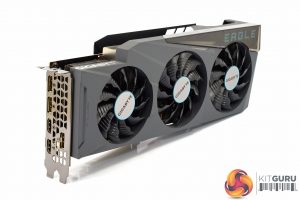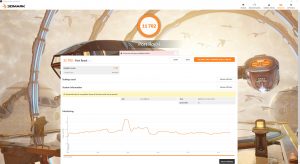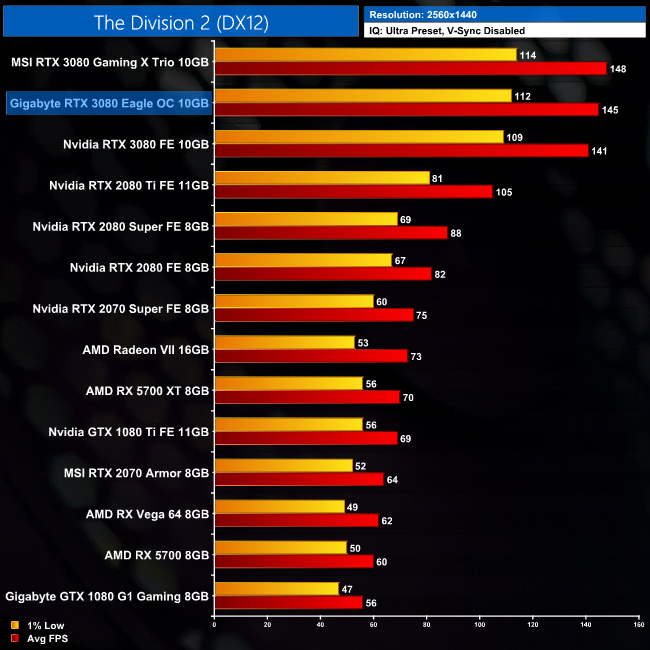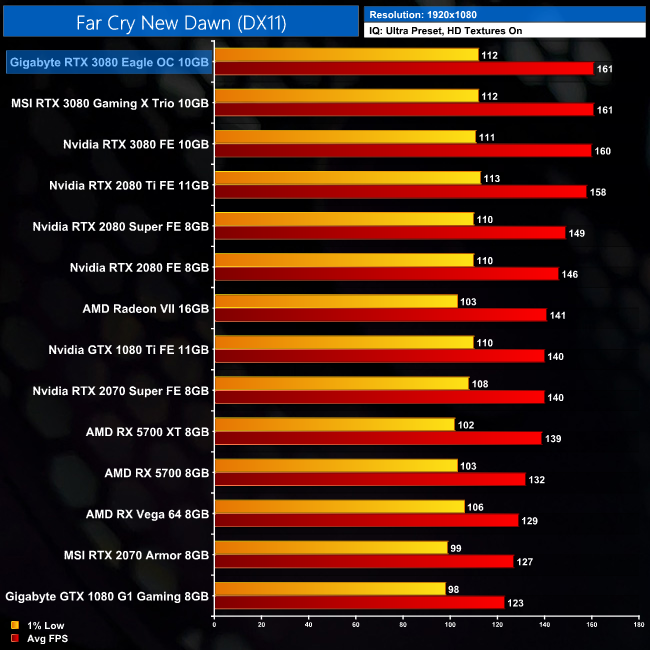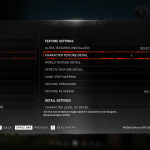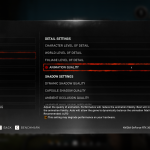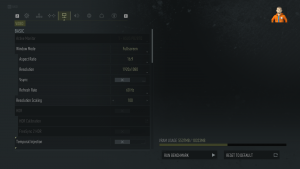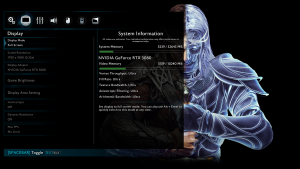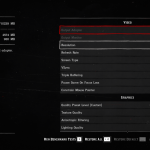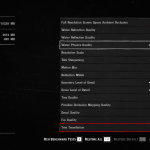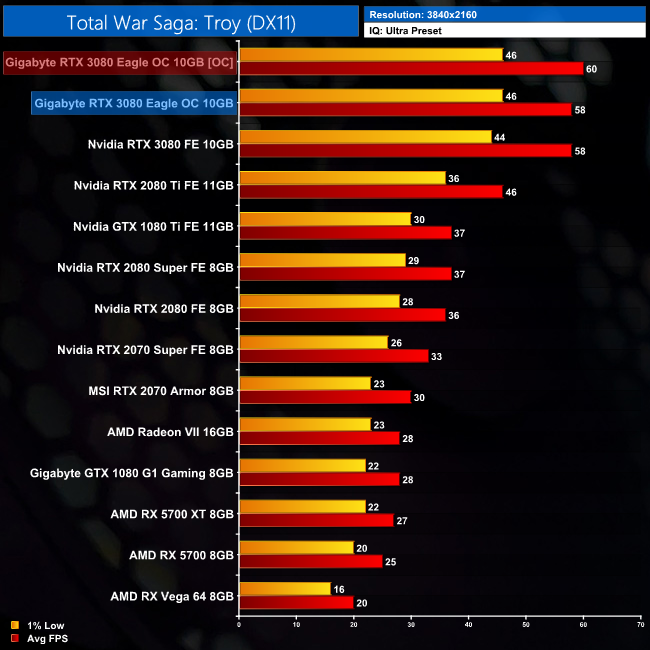
Just twenty four hours have passed since RTX 3080 reviews went live, but we are already back for more. That's because it is now the turn of Nvidia's partners to strut their stuff, with this review focusing on Gigabyte's RTX 3080 Eagle OC. Eagle is a new product series for Gigabyte, replacing the company's entry-level WindForce family, and it'll be particularly interesting to assess this model as it is priced at Nvidia's MSRP, £649 here in the UK. Has the Eagle landed, or is it yet to take off? Let's find out.
On the face of it, the Gigabyte RTX 3080 Eagle OC appears to tick all the boxes for a third-party graphics card. It has a large, triple-fan cooler, factory overclocked core, RGB lighting, full length metal backplate, and tweaked power delivery compared to a reference board. Considering it is coming in at that £649 MSRP, then, it certainly sounds impressive on paper.
In this review, we put the Eagle through its paces to see just how good it is, and whether or not it is worth your hard-earned cash.
| GPU | RTX 3090 | RTX 3080 | RTX 2080 Ti (FE) | RTX 2080 SUPER | RTX 2080 (FE) |
| SMs | 82 | 68 | 68 | 48 | 46 |
| CUDA Cores | 10496 | 8704 | 4352 | 3072 | 2944 |
| Tensor Cores | 328 | 272 | 544 | 384 | 368 |
| RT Cores | 82 | 68 | 68 | 48 | 46 |
| Texture Units | 328 | 272 | 272 | 192 | 184 |
| ROPs | 112 | 96 | 88 | 64 | 64 |
| GPU Boost Clock | 1695 MHz | 1710 MHz | 1635 MHz | 1815 MHz | 1800 MHz |
| Memory Data Rate | 19.5 Gbps | 19 Gbps | 14 Gbps | 15.5 Gbps | 14 Gbps |
| Total Video Memory | 24GB GDDR6X | 10GB GDDR6X | 11GB GDDR6 | 8GB GDDR6 | 8GB GDDR6 |
| Memory Interface | 384-bit | 320-bit | 352-bit | 256-bit | 256-bit |
| Memory Bandwidth | 936 GB/Sec | 760 GB/Sec | 616 GB/sec | 496.1 GB/sec | 448 GB/sec |
| TGP | 350W | 320W | 260W | 250W | 225W |
Just before diving into the details, it's worth reminding ourselves of the key specs for the RTX 3080. Built on Nvidia's GA102 GPU, fabricated on Samsung's 8nm process, RTX 3080 houses 8704 CUDA cores, 68 RT Cores and 272 Tensor cores.
A reference board would come clocked at 1710MHz, but this is the Eagle OC, and accordingly this card has a rated boost of 1755MHz. We do, of course, expect GPU Boost to bring actual frequency well above those levels, but we will look at that later in the review.
The 10GB VRAM is provided thanks to Micron's new GDDR6X memory. Operating at 19Gbps, over a 320-bit bus this gives total memory bandwidth of 760GB/s.
All of those cores, fast memory and factory overclock come at a cost, however, and that is power draw. Reference TGP for a RTX 3080 is 320W, but Gigabyte has bumped this up to 340W, making it one of the most power-hungry GPUs I have ever tested.
Despite the new Eagle series, this graphics card ships in a familiar-looking box, complete with Gigabyte's signature orange accents, with some neon blue artwork also visible on the front.
On the back of the box, Gigabyte highlights a few key features of the card, including its fan design, the RGB lighting and metal backplate.
Gigabyte certainly hasn't gone overboard on the included accessories, as we find a solitary quick start guide in the box.
We're all here for the card though, and it's not a bad-looking piece of kit. I first noticed the unique shape of the shroud, as it almost forms an L-shape due to the way it extends over the sides of the PCB and heatsink. You will also notice a translucent plastic section above two of the fans, which is home to the Eagle brand name.
It's certainly not a boring card to look at, but as it is almost entirely grey, it is still very colour neutral, so you shouldn't have any issues installing this in a system with a specific colour scheme.
We can also note the triple-fan cooler. The fan closest to the I/O bracket is slightly smaller than the other two, measuring 80mm compared to the 90mm diameter of its neighbours. The central fan also spins in reverse, something we have seen on several Gigabyte cards now, and the company claims this reduces turbulence from airflow generated by the fans.
In terms of its dimensions, this is certainly not a small graphics card. Prospective RTX 3080 owners should become well acquainted with this trend, as board partners appear to have universally increased the size of their coolers and heatsinks to deal with the increased power, and therefore heat, demanded by the GA102 GPU.
In the case of the Eagle OC, we don't have official dimensions from Gigabyte at the time of writing, but my measurements put the card at approximately 32cm x 13cm x 5.5cm. As ever, it's worth double checking there is enough space inside your chassis.
Getting a view from the side of the card, one thing I noticed is that there is a fair amount of branding printed on the card, in fairly large letters too. ‘Gigabyte' is printed on both the front side and in the centre of the backplate, while ‘GeForce RTX' is again on the front side and the edge of the backplate. ‘Eagle' is the third brand name printed on the backplate, and as we pointed out above, it is also visible on the underside of the shroud, above the fans. It is safe to say you won't be forgetting exactly who is the maker of this graphics card!
As for the backplate itself, this is a full-length metal plate that matches the grey plastic shroud. Aside from the branding, it is pretty plain, except for that large cut-out to the right-hand side of the card. This simply provides a more open and less restricted airflow path through the heatsink.
Like every custom RTX 3080 GPU, the Eagle OC does not use Nvidia's new 12-pin power connector. Instead, two 8-pin plugs are what's required.
For video outputs, we have three DisplayPort 1.4a connectors, and then two HDMI 2.1 ports. The latter is actually an extra HDMI 2.1 port compared to the Founders Edition, which could prove useful if you want to connect to more than one high-bandwidth display.
In terms of the PCB, Gigabyte appears to have gone for a slightly customised design here. This is most evident in its use of a 13+4 phase VRM, which has added an extra phase for the memory compared to reference. We can also see the company has deployed an extension for its 8-pin power connectors, so the connectors themselves are physically further down the length of the card than if they were directly attached to the PCB itself.
We also get a good look at Micron's GDDR6X memory, with each chip bearing the D8BGW model code. These models are rated for a speed of 19Gbps.
The cooler design for the Eagle is pretty straightforward. Gigabyte is using two fin stacks which are connected by a total of 7 composite copper heatpipes, each of which measure 6mm. The GPU contacts directly with a copper plate, as do the memory modules (via thermal pads). Smaller plates are also used to contact with the VRM and MOSFETs, again via thermal pads.
Driver Notes
- All Nvidia GPUs (except RTX 3000) were benchmarked with the 452.06 driver.
- RTX 3080 was benchmarked with the 456.16 driver supplied to press.
- All AMD GPUs were benchmarked with the Adrenalin 20.8.2 driver.
Test System
We test using the a custom built system from PCSpecialist, based on Intel's latest Comet Lake-S platform. You can read more about it over HERE, and configure your own system from PCSpecialist HERE.
| CPU |
Intel Core i9-10900K
Overclocked to 5.1GHz on all cores |
| Motherboard |
ASUS ROG Maximus XII Hero Wi-Fi
|
| Memory |
Corsair Vengeance DDR4 3600MHz (4 X 8GB)
CL 18-22-22-42
|
| Graphics Card |
Varies
|
| System Drive |
500GB Samsung 970 Evo Plus M.2
|
| Games Drive | 2TB Samsung 860 QVO 2.5″ SSD |
| Chassis | Fractal Meshify S2 Blackout Tempered Glass |
| CPU Cooler |
Corsair H115i RGB Platinum Hydro Series
|
| Power Supply |
Corsair 1200W HX Series Modular 80 Plus Platinum
|
| Operating System |
Windows 10 2004
|
Comparison Graphics Cards List
- MSI RTX 3080 Gaming X Trio
- Nvidia RTX 3080 FE 10GB
- Nvidia RTX 2080 Ti FE 11GB
- Nvidia RTX 2080 Super FE 8GB
- Nvidia RTX 2080 FE 8GB
- Nvidia RTX 2070 Super FE 8GB
- MSI RTX 2070 Armor 8GB
- Nvidia GTX 1080 Ti FE 11GB
- Gigabyte GTX 1080 G1 Gaming 8GB
- AMD Radeon VII 16GB
- AMD RX 5700 XT 8GB
- AMD RX 5700 8GB
- AMD RX Vega 64 8GB
Software and Games List
- 3DMark Fire Strike & Fire Strike Ultra (DX11 Synthetic)
- 3DMark Time Spy (DX12 Synthetic)
- 3DMark Port Royal (DXR Synthetic)
- Control (DX12)
- Death Stranding (DX12)
- The Division 2 (DX12)
- Far Cry New Dawn (DX11)
- Gears 5 (DX12)
- Ghost Recon: Breakpoint (Vulkan)
- Metro: Exodus (DX12)
- Middle Earth: Shadow of War (DX11)
- Red Dead Redemption 2 (Vulkan)
- Shadow of the Tomb Raider (DX12)
- Total War Saga: Troy (DX11)
We run each benchmark/game three times, and present mean averages in our graphs. We use OCAT to measure average frame rates as well as 1% low values across our three runs.
3DMark Fire Strike is a showcase DirectX 11 benchmark designed for today’s high-performance gaming PCs. It is our [FutureMark’s] most ambitious and technical benchmark ever, featuring real-time graphics rendered with detail and complexity far beyond what is found in other benchmarks and games today.
Initial results from our 3DMark benchmarks are pretty much as we expected. The Eagle matches the performance of the RTX 3080 Founders Edition in Fire Strike, before pulling ahead by 2% in both Time Spy and Fire Strike Ultra.
3DMark Port Royal is the world’s first dedicated real-time ray tracing benchmark for gamers. You can use Port Royal to test and compare the real-time ray tracing performance of any graphics card that supports Microsoft DirectX Raytracing. As well as benchmarking performance, 3DMark Port Royal provides a realistic and practical example of what to expect from ray tracing in upcoming games.
Just like 3DMark Time Spy, Port Royal sees the RTX 3080 Eagle improve on Nvidia's Founders Edition by 2%.
Control is an action-adventure video game developed by Remedy Entertainment and published by 505 Games. Control was released on 27 August 2019 for Microsoft Windows, PlayStation 4, and Xbox One. (Wikipedia).
Engine: Northlight Engine. We test using the High preset, with 4x MSAA, DX12 API.
Control is our first game of the day, and the gains for the 3080 Eagle are very consistent – across all three resolutions, the Gigabyte GPU is 2% faster than the Founders Edition.
Death Stranding is an action game developed by Kojima Productions. It is the first game from director Hideo Kojima and Kojima Productions after their split from Konami in 2015. It was released by Sony Interactive Entertainment for the PlayStation 4 in November 2019 and by 505 Games for Windows in July 2020. (Wikipedia).
Engine: Decima. We test using the Very High preset, with TAA, DX12 API.
Despite being a visually impressive title, frame rates are generally high in Death Stranding, and even at 4K this RTX 3080 Eagle pushes over 100FPS on average. At that resolution, it's 2% faster than Nvidia's FE, but the gap is only 1% at 1080p and 1440p.
Tom Clancy's The Division 2 is an online action role-playing video game developed by Massive Entertainment and published by Ubisoft. The sequel to Tom Clancy's The Division (2016), it is set in a near-future Washington, D.C. in the aftermath of a smallpox pandemic, and follows an agent of the Strategic Homeland Division as they try to rebuild the city. (Wikipedia).
Engine: Snowdrop. We test using the Ultra preset, but with V-Sync disabled, DX12 API.
The Division 2 sees the RTX 3080 Eagle take an increased lead versus the Founders Edition. It's still hardly a big improvement, but this Gigabyte GPU is 3% faster at 1440p and 4K.
Far Cry New Dawn is an action-adventure first-person shooter developed by Ubisoft Montreal and published by Ubisoft. The game is a spin-off of the Far Cry series and a narrative sequel to Far Cry 5. It was released for Microsoft Windows, PlayStation 4 and Xbox One on February 15, 2019. (Wikipedia).
Engine: Dunia 2. We test using the Ultra preset, with the HD Textures pack, DX11 API.
Far Cry New Dawn is heavily CPU-limited, especially at 1080p – just look how congested that chart is! At 4K, however, the Eagle delivers 106FPS on average, another 2% improvement over Nvidia's design.
Gears 5 is a third-person shooter video game developed by The Coalition and published by Xbox Game Studios for Microsoft Windows and Xbox One. It is the sixth instalment of the Gears of War series, and is the second Gears of War game not to be developed by Epic Games.
Engine: Unreal Engine 4. We test using the Ultra preset, with Best Animation Quality (instead of Auto), DX12 API.
In Gears 5, the relative gains for the 3080 Eagle versus the Founders Edition increase as we step up in resolution. At 1080p, the difference is 1%, while that increases to 2% at 1440p, and finally to 3% at 4K.
Tom Clancy's Ghost Recon Breakpoint is an online tactical shooter video game developed by Ubisoft Paris and published by Ubisoft. The game was released worldwide on 4 October 2019, for Microsoft Windows, PlayStation 4 and Xbox One, (Wikipedia).
Engine: AnvilNext 2.0. We test using the Very High preset, with AA disabled, Vulkan API.
Ghost Recon: Breakpoint is another title showing signs of a CPU bottleneck at 1080p. At 4K, however, the RTX 3080 Eagle delivers 77FPS on average, 2FPS (3%) more than the Nvidia Founders Edition.
Metro Exodus is a first-person shooter video game developed by 4A Games and published by Deep Silver in 2019. It is the third instalment in the Metro video game series based on Dmitry Glukhovsky's novels, following the events of Metro 2033 and Metro: Last Light. (Wikipedia).
Engine: 4A Engine. We test using the Ultra preset, but with Hairworks and Advanced PhysX turned off, DX12 API.
Just like Breakpoint, Metro Exodus sees the RTX 3080 Eagle net an extra 3% performance versus the Founders Edition, when tested at 4K.
Middle-earth: Shadow of War is an action role-playing video game developed by Monolith Productions and published by Warner Bros. Interactive Entertainment. It is the sequel to 2014’s Middle-earth: Shadow of Mordor, and was released worldwide for Microsoft Windows, PlayStation 4, and Xbox One on October 10, 2017. (Wikipedia).
Engine: LithTech Firebird. We test using the Very High preset, DX11 API.
It's another case of the RTX 3080 Eagle seeings bigger gains at the higher resolutions, when testing Shadow of War. It can only improve on the Founders Edition by 1% at 1080p, but this grows (slightly) to a 2% lead at 1440p and 4K.
Red Dead Redemption 2 is a 2018 action-adventure game developed and published by Rockstar Games. The game is the third entry in the Red Dead series and is a prequel to the 2010 game Red Dead Redemption. Red Dead Redemption 2 was released for the PlayStation 4 and Xbox One in October 2018, and for Microsoft Windows and Stadia in November 2019. (Wikipedia).
Engine: Rockstar Advance Game Engine (RAGE). We test by manually selecting High settings, not using a preset, including TAA, Vulkan API.
The 1080p and 1440p benchmarks for Red Dead Redemption 2 show barely any improvement for the RTX 3080 Eagle, when compared to Nvidia's 3080 design. Its best result comes at 4K, where its extra 2FPS works out as a 2% advantage over the Founders Edition.
Shadow of the Tomb Raider is an action-adventure video game developed by Eidos Montréal in conjunction with Crystal Dynamics and published by Square Enix. It continues the narrative from the 2013 game Tomb Raider and its sequel Rise of the Tomb Raider, and is the twelfth mainline entry in the Tomb Raider series. The game released worldwide on 14 September 2018 for Microsoft Windows, PlayStation 4 and Xbox One. (Wikipedia).
Engine: Foundation Engine. We test using the Highest preset, with TAA, DX12 API.
Shadow of the Tomb Raider is the game where we see the biggest improvements for the RTX 3080 Eagle, relative to the Founders Edition. It's 3% faster at 1440p, and 4% faster at 4K.
Total War Saga: Troy is a 2020 turn-based strategy video game developed by Creative Assembly Sofia and published by Sega. The game was released for Windows on 13 August 2020 as the second installment in the Total War Saga subseries, succeeding Thrones of Britannia (2018). (Wikipedia).
Engine: TW 3 Engine. We test using the Ultra preset, DX11 API.
Total War Saga: Troy is our last game of the day, and it represents a worst-case scenario for gaming with the Gigabyte Eagle, as it registers effectively no improvement over the Founders Edition. The average frame rates of the two cards are identical at 1080p and 1440p, while the Gigabyte edges ahead by a single frame at 4K.
Here we present frame rate figures for each graphics card, averaged across all 11 games on test today. These figures can disguise significant variations in performance from game to game, but provide a useful overview of the sort of performance you can expect at each resolution tested.
Looking at our average results, it's no surprise to see the RTX 3080 Eagle come in marginally ahead of the Founders Edition at every resolution. Even at 1080p, where the CPU is a significant limiting factor for this GPU, the Eagle averages 1% increased frame rates.
At 1440p and 4K, the Eagle is 2% faster than Nvidia's design. It's by no means a big jump forward, but it certainly seems Ampere has been delivered pretty close to its limits, so any factory overclocks won't result in huge gains.Using the average frame rate data presented on the previous page, here we look at the cost per frame using the UK MSRP launch prices for each GPU.
As the Eagle is the same price as the RTX 3080 MSRP – £649 – but offers slightly more performance, its cost per frame is even more attractive than the Founders Edition, with a price of £7.91 per 4K frame. This is not far from a 50% discount per frame compared to the RTX 2080.
Here we present the average clock speed for each graphics card while running the 3DMark Time Spy stress test for 30 minutes. We use GPU-Z to record the GPU core frequency during the Time Spy runs. We calculate the average core frequency during the 30 minute run to present here.
Click to enlarge.
With a rated boost clock of 1755MHz, the Eagle should be about 45MHz faster than the Founders Edition. In fact, it does slightly better than this, recording an average frequency of 1913MHz across our 30 minute Time Spy stress test. This works out at 57MHz faster, on average, than the Founders Edition.
For our temperature testing, we measure the peak GPU core temperature under load. A reading under load comes from running the 3DMark Time Spy stress test for 30 minutes.
Thermal performance for the Eagle is impressive. While we need to test more cards to see how this design compares to other AIB cards, objectively speaking a sub-70C temperature is always what we want to see, so it's definitely good work here on Gigabyte's part.
We take our noise measurements with the sound meter positioned 1 foot from the graphics card. I measured the noise floor to be 32 dBA, thus anything above this level can be attributed to the graphics cards. The power supply is passive for the entire power output range we tested all graphics cards in, while all CPU and system fans were disabled. A reading under load comes from running the 3DMark Time Spy stress test for 30 minutes.
We've seen that the Eagle's thermal performance is very solid, but does that come at the cost of noise? Thankfully, the answer is no. We measured noise output coming in at 40db, with the fans spinning at around 1680rpm when under full load. This is marginally louder than the Founders Edition, and undoubtedly we will see some cards coming in quieter – like the MSI Gaming X Trio we have also tested today. However, it is still by no means a loud card, and as the GPU’s fans would be barely noticeable over the noise of your system fans, I really can’t complain here.
We measure system-wide power draw from the wall while running the 3DMark Time Spy stress test for 30 minutes.
In terms of total system power draw, we measured consumption at the 475W mark, an increase of just over 20W compared the Founders Edition.
We also use GPU-Z to measure Board Power (graphics card-only power draw). This is currently only available for Nvidia cards, which is why we have excluded AMD results from the chart. Aside from the fact this is software-based reporting, and not a hardware measurement of the PCIe power cables and PCIe slot (for that we’d need something like PCAT), this should provide us more accurate data to work with as it is measuring only the GPU power, and not total system power which is a fundamentally imprecise measurement.
The reason for the increase in total system power draw, is the RTX 3080 Eagle has a 340W power target, and we see it hitting that target almost exactly when looking at only total board power of each card. This is exactly 20W higher than the Founders Edition, so hardly a huge increase, but 320W was always quite a lot to begin with for a single GPU.
By using the GPU-Z Board Power data in conjunction with the 11-game average FPS data we presented earlier in this review, we can work out performance per Watt for each graphics card. This is presented as FPS per Watt.
Due to the increase in power, coupled with the very small (2%) performance gains, the RTX 3080 Eagle does offer very slightly worse performance per Watt than the Founders Edition. It's not much at all, but it is an interesting point nonetheless.
We use MSI Afterburner to overclock the graphics card. It was difficult to squeeze much more out of the Eagle, and we could only manage a +40MHz GPU offset, and a +750MHz memory offset, bringing speeds up to 20.5Gbps.
This wasn't much of an overclock at all, so it's not surprising to see the RTX 3080 Eagle only running 3-4% faster with the additional frequency. Once more, it does seem there is simply very little performance headroom left to tap into for Ampere, when it comes to overclocking.
As one of the first third-party RTX 3080 cards to pass through our labs, the Gigabyte RTX 3080 Eagle OC has certainly impressed. Replacing the WindForce family, this new Eagle series appears to have the same focus on cost-effective graphics cards, with this RTX 3080 model hitting the shelves at £649, so you're not paying a price premium over the MSRP.
First of all, it's worth re-capping the gaming performance of this graphics card. Given the Eagle has a 45MHz rated clock speed advantage over Nvidia's Founders Edition, we weren't expecting to see any huge gains to our frame rates. In fact, at 1440p and 4K, the Eagle is just 2% faster on average.
Of course, being an RTX 3080, this still means performance is the best we have ever seen, and compared to the RTX 2080 Ti, this GPU is 35% faster at 4K. Up against the RTX 2080 Super, the difference is 62%, while the Eagle is 72% faster than the RTX 2080. In short, it is a beast of a gaming GPU.
Gigabyte's team has also done a very good job at designing a GPU that runs cool and quiet. We saw its GPU temperature peak at just 67C during our testing, and while we can't yet comment if this is better or worse than other custom cards, it's certainly a healthy reduction of 9C compared to the Founders Edition.
As for noise levels, we did record the Eagle about 1dBa louder than the Founders Edition, with total output at 40dBa. This is still pretty quiet, however, and I certainly don't see it as a big deal at all, particularly as there is plenty of thermal headroom to play around with a less aggressive fan curve. In terms of its out of the box behaviour though, the fan spun at 1680rpm, but it's still not a loud card at all.
Power draw has been bumped up by 20W compared to the Founders Edition, with a 340W power target. This brought total system power draw up to 475W in our testing, so if you have a 500W PSU it would definitely be time to upgrade.
Unfortunately, the extra power headroom didn't yield much benefit when overclocking, as it seems Ampere is already right at its limits. We saw 3-4% gains from our best overclock, so I suppose it is something, but gone are the days when an extra 10% performance (or more) could be gained from an overclock.
All told then, the Gigabyte RTX 3080 Eagle OC is a very solid card, without any glaring weaknesses. It may not offer any innovative new features, or radical improvements over the Founders Edition… but it's not trying to. It's simply a decent card that will get the job done, and do it well, while also coming in at MSRP. Some gamers may want to pay a little more for a card with more bells and whistles, but for many I imagine this would be pretty much perfect. If you want the performance of an RTX 3080 without paying any price premium for it, then the Eagle is a fantastic option.
You can buy this card for £649.99 from Overclockers UK HERE.
Discuss on our Facebook page HERE.
Pros
- Colour-neutral design.
- Slightly faster than Founders Edition.
- Priced at MSRP, or £649.
- GPU temperatures stayed below 70C at all times.
- Two HDMI 2.1 ports, instead of just one.
Cons
- Limited overclocking headroom.
- Very slightly higher noise levels than the Founders Edition.
KitGuru says: The Eagle has landed. If you're looking for a third-party RTX 3080 that's still priced at MSRP, the Gigabyte Eagle is an excellent all-round card.
 KitGuru KitGuru.net – Tech News | Hardware News | Hardware Reviews | IOS | Mobile | Gaming | Graphics Cards
KitGuru KitGuru.net – Tech News | Hardware News | Hardware Reviews | IOS | Mobile | Gaming | Graphics Cards







